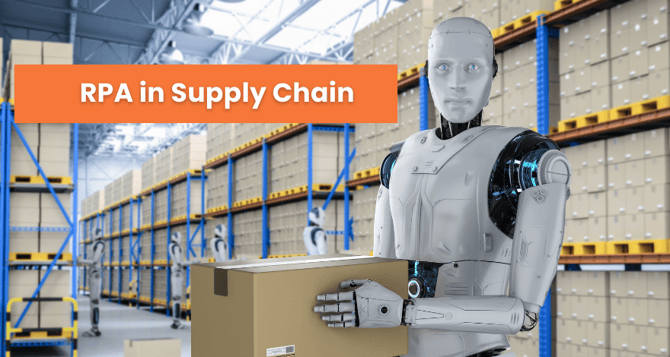Use Cases of RPA in Supply Chain
Explore the transformative impact of Robotic Process Automation (RPA) in the supply chain. From automating order processing to optimizing inventory management, RPA enhances efficiency, minimizes errors, and provides real-time insights, fostering a responsive and cost-effective supply chain ecosystem

In the ever-evolving landscape of supply chain management, organizations are constantly seeking innovative solutions to enhance efficiency, reduce costs, and improve overall operational effectiveness. One such revolutionary technology making waves in the supply chain industry is Robotic Process Automation (RPA). This article delves into the use cases of RPA in the supply chain and how it is transforming traditional processes.
RPA can improve supply chain management and logistics by automating repetitive time-consuming tasks such as data entry, in turn improving workflows. RPA uses automated software robots or bots to extract data from one application and paste it into another.
RPA technology is not as sophisticated or fast as some other integration techniques but can be easier to implement. It can also facilitate complementary technologies.
Here are several ways companies are weaving RPA into logistics and supply chain workflows.
Data Entry Automation
Robotic Process Automation (RPA) addresses data entry challenges in the supply chain by automating the process. Intelligent bots ensure rapid and error-free data input, mitigating the risks associated with manual entry. This not only enhances accuracy but also accelerates data processing, enabling a more efficient and streamlined supply chain. RPA's contribution to data entry automation results in improved operational efficiency, reduced errors, and increased overall agility in managing critical supply chain information.
Predictive Maintenance
Maintaining equipment is an important aspect of supply chain management, and RPA working with other technologies can help by facilitating predictive maintenance efforts.
As an example, in an oil and gas manufacturing plant, IoT-based predictive maintenance can identify corrosion and pipeline damage. These IoT applications then use sensors installed across the pipeline to obtain data on the potential for hydrogen and gaseous content. The applications retrieve sensor data in real-time and transmit it to the cloud for evaluation, analysis, and prediction.
RPA bots act on this information by automating the process of scheduling maintenance and updating financial plans. This eliminates delays that would normally be attributed to manual labor, improves response times, reduces employee effort, and enhances operational efficiencies.
Logistics Management
RPA can bring efficiencies to the delivery phase of the supply chain.
In these cases, RPA bots monitor orders and update the order handover details across all relevant systems. They can also work in conjunction with AI-based intelligent routing systems that coordinate between multiple logistics partners, such as road freight, cargo ships, and air freight. The bots are capable of automatically assigning a delivery partner based on the location of the products.
RPA bots can also generate notifications to customers if there's a delay, enhancing customer experience with practice and real-time order updates. In essence, the technology improves error handling. RPA is particularly useful in managing cross-border shipments that may require various additional customs, storage, and inspection processes that need to be coordinated.
After-Sales Service
What happens after a sale is becoming increasingly important, and RPA can work with several other technologies to improve that aspect of supply chain management.
For example, when a customer places a service request using a mobile app, an intelligent virtual assistant or chatbot can interact with customers and then place requests in the system. Intelligent document processing applications can read data from various service request document formats and then coordinate with RPA bots to capture and maintain service ticket data.
If a customer needs to make a return, a mobile app for third-party servicing and reverse logistics partners can improve visibility on location, time of arrival, and duration to complete work in case of repairs. RPA bots can track orders in real-time and send acknowledgment emails to customers automatically.
Initiating Purchase Orders
Organizations' supply chain departments can use an RPA bot to check inventory levels and initiate a purchase order when supply levels dip below a specified threshold. Most companies have a purchase order template or online ordering process set up with their vendors, and the structured nature of purchase order information lends itself to automation.
Keeping an efficient supply chain process reduces the risk of lost sales due to a shortage of material or stock, ensuring that companies can manage optimal inventory levels. Companies need to be able to manage their supply during peak and trough demand.
Production facilities generate reports on the inventory levels of raw materials, works in process, and finished goods. IT can configure an RPA bot to sync with the company's CRM system. Based on the report info, the RPA bot can communicate with the appropriate supplier via email or an ordering portal to place an order.
The purchasing manager would only need to monitor the notifications and approve the request. In organizations with multiple suppliers and high-volume production, this process can occur hundreds of times per day.
Order Management
Automation for routine and repetitive manual tasks, such as load matching with transport availability and order management, can be difficult to implement directly into the existing ERP. Robotic process automation technology can make this easier to accomplish.
RPA can also help bring data together from across multiple data silos, such as organizational management modules, Excel sheets, and web portals.
Front-line workers can call on these RPA bots to perform other repetitive tasks, such as emailing, initiating calls, and collating reports.
Supply Chain Diversity
RPA can help companies build a more resilient supply chain in the wake of COVID-19 by bringing automation to supplier relationships.
Business leaders should develop a resilience automation strike team and a roadmap to scale up any processes using automation
When companies combine RPA software with machine learning, they can gather data from vendors and customers, run simulations, and analyze alternatives. This improves supply chain diversity. Intelligent automation layers AI on top of RPA and can help prepare a request for a quotation package and allow access to a wider set of vendors.
These same tools can help organize the data from vendor documents, allowing technicians to compare it. RPA bots can also help perform background "due diligence" tasks, such as running credit and compliance checks, to streamline the vendor selection process.
An industrial manufacturer can use a bot to automatically collect and compare sales forecasts, manufacturing capacity, and supply data from its vast network of suppliers every month and flag any constraints or discrepancies.
Other bots can verify new product data to ensure that the bill of materials and other associated parameters are accurate and in sync across engineering, procurement, and planning systems. This process uses RPA to validate its supply chain plans.
Conclusion
Incorporating Robotic Process Automation into supply chain management processes brings forth a myriad of benefits, from increased efficiency and accuracy to improved customer satisfaction and reduced operational costs.
Your RPA Solution is a Click Away. Contact Us!
Discover personalized automation strategies that perfectly align with your business goals and aspirations.
As the supply chain landscape continues to evolve, organizations embracing RPA are better positioned to adapt, innovate, and stay ahead of the competition.


%201-1.webp)


.png?width=344&height=101&name=Mask%20group%20(5).png)







%20with%20OpenAI%20Language%20Models.png?width=352&name=Robotics%20Process%20Automation%20(RPA)%20with%20OpenAI%20Language%20Models.png)









